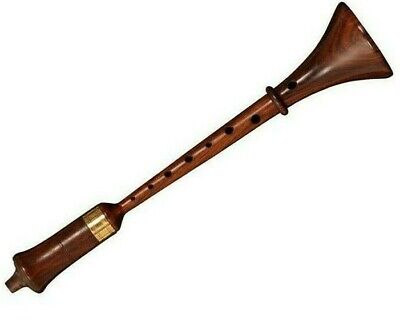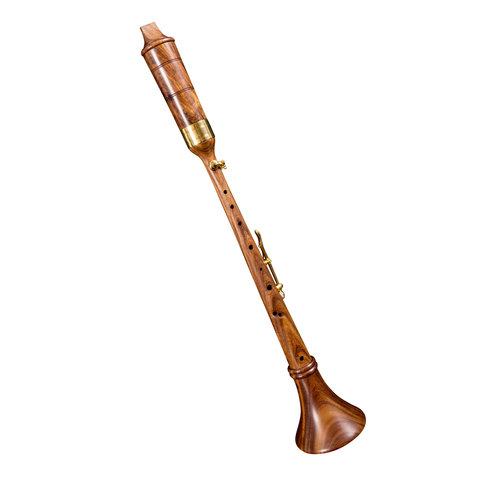Rauschpfeife
Woodwinds
Europe
Between 1001 and 1900 AD
Video
The rauschpfeife is a captivating double-reed instrument that emerged during the Renaissance, known for its loud and distinctive sound. With its unique construction and historical significance, the rauschpfeife has become a cherished instrument among enthusiasts of early music.
The kortholt (also spelled korthold or cortholt) is a type of double-reed instrument that has a unique design and mechanism. It is related to the shawm family and is typically used in medieval and Renaissance music. The rauschpfeife features a conical bore and is typically made from wood, such as sycamore or boxwood. It is characterized by its capped double reed, which is enclosed in a windcap. This design allows the instrument to produce a powerful, reedy sound that is particularly effective for outdoor performances. The player blows air into a slot in the windcap to create sound, while the finger holes on the body enable pitch variation.
Historical Origin
Historically, the rauschpfeife originated in Germany during the late 15th century and gained prominence throughout Europe in the 16th and 17th centuries. Its name translates to “rush pipe,” derived from the Old German word rusch, meaning rush or reed. This reflects its construction from materials found in nature. The instrument was commonly used in various musical ensembles, including court music and folk traditions, and was often associated with festive occasions and outdoor events. The rauschpfeife was particularly favored by musicians in royal courts, including those of Henry VIII in England, where it was part of ceremonial music. Its popularity peaked during the Renaissance, but it gradually fell out of favor as other instruments, such as the oboe and clarinet, became more prominent.
Mechanism of the Kortholt
Double-Reed Mouthpiece: Like other members of the double-reed family (e.g., oboe, bassoon), the kortholt uses a double reed to produce sound. The reed is made from cane, and when air is blown between the two reeds, they vibrate to create the sound.
Bore and Tone Holes: The kortholt typically has a conical bore, meaning the tube gradually narrows towards the bell. This helps produce its characteristic tone, which is bright and reedy. The instrument has several finger holes along its length that the player can cover or uncover to change the pitch.
Finger Technique: The pitch is controlled by covering and uncovering the tone holes along the body of the kortholt. The instrument requires precise finger placement to produce the correct notes, similar to other woodwind instruments. The player’s embouchure (how the mouth and lips interact with the reed) is also important for controlling the sound’s volume and tone quality.
Drones and Tuning: In some versions, the kortholt may have drone pipes that produce a constant harmonic note to accompany the melody. This feature is particularly common in instruments like the shawms and other traditional reed instruments, offering both melodic and harmonic roles in musical performance.
Material and Construction: Traditionally, the kortholt was made from wood, often using dense hardwoods like boxwood or maple. The reed is usually made from cane or, in some historical cases, from the wood of certain trees. The bell of the instrument may flare out, contributing to its sound projection.
Function in Music
The kortholt, like other instruments in the shawm family, is used to perform melodies in both ensemble and solo settings. Its sound is bold and bright, capable of standing out in outdoor performances and ceremonies. It was often employed in military bands, court music, and other large ensemble settings in the Medieval and Renaissance periods.
Types
There are several types of rauschpfeifen based on size and pitch:
- Sopranino Rauschpfeife: The highest-pitched variant, ideal for melodic lines.
- Soprano Rauschpfeife: A common size used in ensembles.
- Alto Rauschpfeife: Provides a mid-range voice suitable for various musical contexts.
- Tenor Rauschpfeife: Produces deeper tones that enrich ensemble sound.
Each type serves specific roles within musical compositions, allowing for a diverse range of sounds when played together.
Features and Significance
The rauschpfeife is distinguished by several key features. This design allows players to produce sound without direct contact with the reeds, resulting in a warm and resonant tone. Known for its powerful projection, making it suitable for outdoor performances alongside other instruments like trumpets and drums. The rauschpfeife holds significant historical value as it reflects Renaissance music practices and social customs. It symbolizes rural life while being part of formal musical settings.
In modern times, interest in early music has led to a revival of instruments like the rauschpfeife. Contemporary makers produce replicas that honor historical designs while allowing musicians to explore this unique instrument’s sound and repertoire.In conclusion, the rauschpfeife is more than just an instrument; it embodies a rich cultural heritage that spans centuries. Its distinctive sound, unique construction, and historical context make it an important part of early music traditions. Whether played in folk settings or formal performances, the rauschpfeife continues to captivate musicians and audiences alike with its melodic charm and vibrant history.
FAQ
What is the Rauschpfeife and its key characteristics?
The Rauschpfeife is a loud double-reed wind instrument from the Renaissance period. It features a conical bore and produces a powerful, piercing tone, making it suitable for outdoor performances and ceremonial occasions.
How does the Rauschpfeife differ from other wind instruments of its era?
The Rauschpfeife stands out due to its capped double reed, which protects the reed and allows players to produce sound without direct contact. This, combined with its loud volume, distinguishes it from softer instruments like the recorder.
What materials were traditionally used to make the Rauschpfeife?
Traditional Rauschpfeifen were crafted from wood, such as maple or boxwood, and featured brass or wooden keys to extend their range and improve playability.
 Links
Links
References
Other Instrument
Categories



















